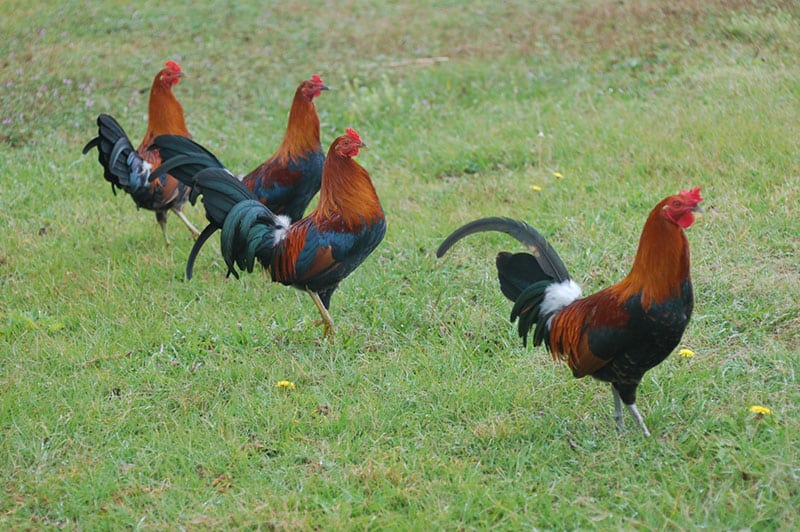Have you ever heard of the Marsh Daisy chicken? This breed’s development began in the 1800s in the United Kingdom and it was never recognized by any large organizations and never developed outside of their home country. Despite that, they are a hardy, dual-purpose breed and programs have begun to restore their population.
Let’s take a look at what makes them special and why you may want to consider adding one to your backyard or farm.

Quick Facts about the Marsh Daisy Chicken
| Breed Name: | Marsh Daisy |
| Place of Origin: | Lancashire, England |
| Uses: | Meat, Eggs |
| Rooster (Male) Size: | Up to 6.5 pounds |
| Hen (Female) Size: | Up to 5.5 pounds |
| Color: | Wheaten, buff, brown, black, white |
| Lifespan: | 7–10 years |
| Climate Tolerance: | All climates |
| Care Level: | Beginner |
| Production: | Meat production, egg production |
Marsh Daisy Chicken Origins
Marsh Daisy chicken is a rare breed of chicken that originated in Lancashire, England in the 1800s. A man named John Wright is the pioneer behind the breed. White Leghorn hens were initially bred with a Black Hamburg rooster, then Game and Malay breeds were later added to the crossbreeding.
For 30 years, Mr. Wright kept his new breed as a closed flock until 1913 when he sold some to another gentleman, Charles Moore, who then added a Pit Game Cock and Sicilian Buttercups into the mix of breeds. Other keepers started breeding the Marsh Daisy and by 1920 a Marsh Daisy Club was formed.
Marsh Daisy breed never received recognition by any large organizations like the American Poultry Association and no flocks of the breed took off outside of their home country.

Marsh Daisy Chicken Characteristics
Hardy
Marsh Daisy chickens are a very hardy breed that fare well in different climates, including colder weather conditions. They get their name from being a more disease-resistance chicken, allowing them to thrive in rain and marshy weather conditions.
The breed is also a fantastic forager and is well known for helping its keepers maintain control of unwanted grasses and weeds. This knack for foraging makes them excellent free-range birds.
Active
They are an active breed that tends to be longer-lived than some other chickens. They are much slower to grow than most other breeds of similar size. Thanks to their ancestry, they have the appearance of a game bird and come in five different color varieties including buff, brown, wheaten, black, and white.
Economical
Marsh Daisy is considered an economical breed that can serve dual-purpose for egg and meat production. The hens are excellent layers that produce up to 250 tinted eggs each year.
Docile
The breed is described as being friendly, quiet, and calm though they are very active and most enjoy moving around foraging. They do well with other chickens and are very handleable, making them a good choice for beginner keepers.
Uses
The Marsh has been used for both meat and egg production. The hens can lay anywhere from 200 to 250 eggs per year and they lay well for approximately three or four years. The eggs are tinted and not too large in size.
In addition to being decent layers, the Marsh Daisy are great foragers and have been known to help keepers control weeds and grass.
Appearance & Varieties
The Marsh Daisy has a build that somewhat resembles a game bird with nicely rounded breasts. The most common color varieties for this breed are Buff, Brown, and Wheaten. There are Black and White varieties, but they are much rarer. Work is being done by breeders to try and restore both the Black and White Marsh Daisies.
A Marsh Daisy rooster will reach around 2.95 kilograms once fully mature with a magnificent red-colored rose comb and white earlobes. The hens reach up to 2.5 kilograms. The breed has red eyes, yellowish-green colored legs, and the tail is helped upward.
Population
The Marsh Daisy is not found outside the United Kingdom and even there, the numbers are quite low. According to The Marsh Daisy Breeder’s Group, less than 200 breeding females remain in the United Kingdom.
The breed has been added to the Rare Breed Survival Trust Watch List and the Rare Poultry Society has given these chickens protection. The Marsh Daisy Breeder’s Group has begun a rescue project and breeding program to help restore the breed.

Are Marsh Daisy Chickens Good for Small-Scale Farming?
The Marsh Daisy does well with climate tolerance, is decent egg layers, and is also useful for meat production. To top it off, their foraging abilities will help to keep grasses and weeds under control. The economical Marsh Daisy would be a great choice for small-scale farming if the breed were more common.
Unfortunately, for any keepers outside the United Kingdom, the Marsh Daisy will be very difficult to come by. Even those in the United Kingdom would have to do their research, as the breed’s numbers are low within their own country.

Conclusion
The Marsh Daisy chicken may be a rare breed that never received recognition from any large poultry organizations, but they are an all-around economical, friendly, and hardy breed that deserves recognition. Hopefully, with the ongoing efforts in the United Kingdom to restore the breed, the Marsh Daisy will soon flourish in numbers and many more keepers can enjoy this amazing bird.
Related bird reads:
Featured Image Credit: Blue Tick Sugar Images, Shutterstock
